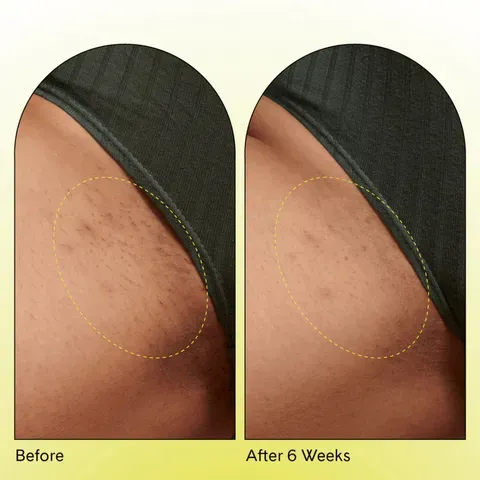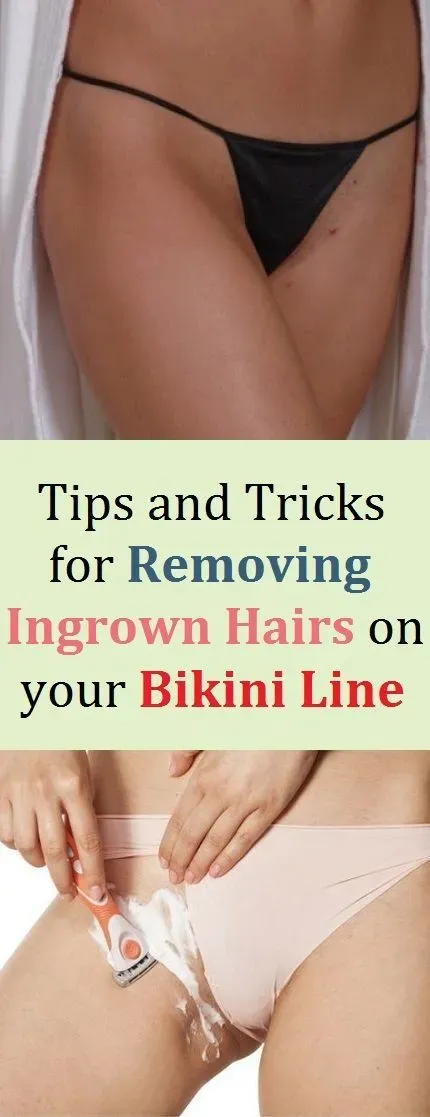Table of Contents
That red, tender bump in the bikini area. It's the unwelcome guest nobody invited, often arriving just when you were planning to feel your most confident. Dealing with ingrown hairs down there is a frustrating reality for many, causing discomfort, irritation, and sometimes, outright pain. If you're tired of battling these persistent little nuisances and wondering **how to remove ingrown bikini hair** effectively and safely, you've landed on the right page.
Understanding Ingrown Bikini Hair: Why It Happens Down There

Understanding Ingrown Bikini Hair: Why It Happens Down There
The Mechanics of a Misguided Hair
let's talk about why these little devils show up specifically in the bikini area. It's not just bad luck; there's a whole process happening. Think about the hair itself. Down there, it's typically thicker and curlier than the hair on your arms or legs. When you remove it, whether by shaving, waxing, or plucking, you're creating a blunt or sharp tip on that hair strand. As this hair starts to regrow, instead of pushing straight up and out of the follicle opening like it's supposed to, that sharp or curled tip can easily pierce the skin surface nearby or even curl back into the follicle wall itself. It's like the hair gets confused and decides to take a detour underground.
Add to this the fact that the skin in the bikini area can be quite sensitive and is often covered by clothing. This can lead to friction, which further irritates the area and might push growing hairs back into the skin. Plus, dead skin cells can accumulate around the hair follicle opening, acting like a tiny roadblock. The poor hair, trying to emerge, hits this barrier and gets deflected sideways or downwards. Your body, sensing this foreign object (the trapped hair), mounts an immune response, causing the inflammation, redness, and tenderness you feel. It's a perfect storm for irritation and those classic ingrown bumps.
- Thick, coarse hair is harder to grow straight out.
- Curly hair naturally wants to curl back towards the skin.
- Shaving creates a sharp tip that can pierce the skin.
- Waxing/tweezing can break the hair below the surface, causing it to grow incorrectly.
- Dead skin cells can block the follicle exit.
- Tight clothing causes friction and irritation.
Tried and True Methods: How to Remove Ingrown Bikini Hair at Home

Tried and True Methods: How to Remove Ingrown Bikini Hair at Home
Applying Heat and Exfoliation
Alright, so you've spotted the enemy: that tell-tale red bump or maybe you can even see the hair trapped just under the skin. Don't panic and definitely don't attack it with your fingernails. The first line of defense for **how to remove ingrown bikini hair** at home involves heat and gentle persuasion. Applying a warm compress is like sending a peace treaty to the irritated skin. Soak a clean washcloth in warm (not scalding!) water, wring it out, and hold it against the ingrown hair for about 10 to 15 minutes. Do this a few times a day. The warmth helps to open up the pores and soften the skin, making it easier for that stubborn hair to make its exit.
Once the area feels a bit less angry and maybe the hair is closer to the surface, you can try some gentle exfoliation. Remember, gentle is the operative word here. Harsh scrubbing will just make everything worse. A soft washcloth used in circular motions in the shower can help slough off dead skin cells that might be blocking the follicle. You could also use a mild exfoliating scrub containing salicylic acid or glycolic acid – these acids help dissolve the glue holding dead skin cells together. Apply it lightly, rinse well, and pat dry. The goal is to clear the path for the hair, not sandblast your skin off.
Careful Extraction and Soothing Steps
If, after using warm compresses and gentle exfoliation, you can clearly see the loop of hair right at the surface of the bump, you might attempt a careful extraction. Emphasis on *careful*. You will need sterile tools for this – think a sterile needle or sterilized tweezers. Clean the area thoroughly with rubbing alcohol first. Then, using your sterile tool, very gently tease the exposed hair loop out from under the skin. The aim is just to free the trapped end, not to pull the entire hair out (unless it lifts out with zero resistance). If the hair isn't visible or is deep, stop. Poking around blindly is a recipe for infection and scarring. Seriously, step away from the tweezers if you can't see what you're doing.
After any attempt at extraction or after your gentle exfoliation routine, it's crucial to soothe the area. Apply a product specifically designed for post-shaving or ingrown hair care. These often contain anti-inflammatory and mild exfoliating ingredients. Look for serums, lotions, or pads with ingredients like witch hazel, aloe vera, or salicylic acid. These can help reduce redness, prevent infection, and keep the skin soft to encourage proper hair growth going forward. Treating the area kindly after intervention is just as important as the intervention itself when learning **how to remove ingrown bikini hair** without lingering consequences.
Some common soothing and preventive ingredients found in products:
- Salicylic Acid: Helps exfoliate and unclog pores.
- Glycolic Acid: Another alpha hydroxy acid for exfoliation.
- Witch Hazel: Natural astringent and anti-inflammatory.
- Aloe Vera: Soothes and reduces redness.
- Tea Tree Oil: Has antiseptic properties (use diluted).
When Home Remedies Aren't Enough: Seeking Professional Help for Ingrown Hair

When Home Remedies Aren't Enough: Seeking Professional Help for Ingrown Hair
Recognizing When You Need Backup
Look, we all like to think we can handle things ourselves. Stubborn jar lid? I got this. Minor cooking mishap? No problem. But an ingrown hair that's swollen, throbbing, and looks like it's plotting world domination from beneath your skin? That's different. There comes a point when your warm compresses and gentle exfoliation aren't making a dent, or worse, the situation is escalating. If you see increasing redness spreading beyond the bump, significant pain, swelling, or a cloudy, pus-filled head forming, you're likely dealing with an infection or a deeply embedded hair that home methods can't safely address. Trying to play dermatologist with a safety pin in a sensitive area is ill-advised, bordering on reckless. These are clear signals that it's time to put down the DIY kit and call in a professional.
Professional Extraction and Medical Intervention
When you consult a doctor, likely a dermatologist, for a problematic ingrown bikini hair, they possess the sterile tools and expertise needed to resolve the issue safely. They can make a tiny, precise incision to release a deeply trapped hair without causing unnecessary trauma or introducing bacteria. This isn't like popping a zit; it's a minor medical procedure aimed at minimizing scarring and infection risk. Beyond physical extraction, a professional can prescribe medications. Topical or oral antibiotics can knock out an infection. Steroid creams can dramatically reduce inflammation and pain. For recurring issues or particularly stubborn cases, they might suggest prescription-strength exfoliants like retinoids to help prevent future ingrowns by keeping follicles clear. They diagnose the severity and tailor the treatment, which is a significant upgrade from guessing what to slather on it from your bathroom cabinet.
- Signs you need professional help:
- Severe pain or tenderness
- Spreading redness or warmth
- Presence of pus
- Bump is growing larger
- Fever or feeling unwell (rare, but indicates serious infection)
- Ingrown hair is deep and not visible
- Home treatments aren't working after a week or two
Long-Term Solutions Beyond Home Care
If you're stuck in a never-ending cycle of ingrown hairs in the bikini area, constantly battling bumps and irritation after every hair removal attempt, it might be time to consider options that offer more than just temporary relief. While learning **how to remove ingrown bikini hair** is useful for immediate problems, addressing the root cause – the hair itself and how it regrows – can prevent future issues. Professionals can discuss and perform treatments like electrolysis or laser hair removal. These methods target the hair follicle, damaging it over time and reducing or eliminating hair growth in the treated area. Fewer hairs growing means significantly fewer opportunities for those hairs to become ingrown. It’s a strategic pivot from reactive treatment to proactive prevention, offering a more permanent escape from the ingrown hair struggle.
Preventing the Pests: Stopping Ingrown Bikini Hair Before It Starts

Preventing the Pests: Stopping Ingrown Bikini Hair Before It Starts
Setting the Stage: Prepping for a Smooth Session
let's talk offense instead of just defense. The absolute best way to deal with ingrown bikini hair is to prevent it from ever showing up. This starts before you even pick up a razor or wax strip. Think of it like prepping a garden bed before planting; you need the right conditions. First, cleanliness is non-negotiable. Always start with freshly washed skin to remove bacteria, sweat, and oils. The best time to remove hair is usually towards the end of a warm shower or bath. The heat and steam soften the hair and open up the follicles, making everything easier and less traumatic.
Next, exfoliation. This is your secret weapon against those little hairs getting trapped by dead skin cells. Gently exfoliating the bikini area *before* hair removal helps clear the path. You don't need anything harsh; a soft washcloth, an exfoliating mitt, or a mild body scrub will do the trick. Focus on light, circular motions. The idea is to remove the surface layer of dead skin, not to scrub yourself raw. Prepping properly minimizes the obstacles the hair faces when it tries to grow back, which is half the battle won.
Execution and Aftercare: The Nitty-Gritty Details
Now for the actual hair removal part. If you're shaving, the tool matters. A dull razor is your enemy here; it drags and pulls at the hair, increasing the likelihood of an uneven cut that encourages ingrowth. Always use a sharp, clean blade. And for the love of smooth skin, use a lubricating shaving gel or cream. It creates a cushion between the blade and your skin, allowing for a smoother glide and less irritation. Apply a generous amount and let it sit for a minute to further soften the hair. The direction of your strokes is critical too: always shave *with* the direction of hair growth in the bikini area. This might not give you that perfectly baby-smooth feel you get from shaving against the grain, but it drastically reduces irritation and the chance of the hair curling back.
After you've finished, rinse the area thoroughly with cool water to close the pores. Pat the skin dry gently with a clean towel; don't rub. Immediately follow up with a soothing, alcohol-free product. Look for lotions or serums specifically designed to calm skin after shaving or to prevent ingrown hairs. Ingredients like aloe vera, witch hazel, or salicylic acid can help reduce inflammation and keep the follicle opening clear. And here's a tip that often gets overlooked: avoid tight clothing right after hair removal. Friction from snug underwear or pants can irritate the sensitive skin and push developing hairs back inwards. Give your skin some breathing room in loose, soft fabrics.
Key Prevention Steps:
- Cleanse skin before hair removal.
- Exfoliate gently beforehand.
- Use a sharp razor or proper waxing/tweezing technique.
- Always use shaving gel/cream.
- Shave *with* the direction of hair growth.
- Rinse blade frequently.
- Pat skin dry afterward.
- Apply a soothing post-shave product.
- Avoid tight clothing immediately after.
Putting an End to the Ingrown Hair Battle
Navigating the world of hair removal, especially in the sensitive bikini area, often means encountering the unwelcome reality of ingrown hairs. While frustrating and sometimes painful, understanding why they happen and adopting careful techniques can significantly reduce their impact. From gentle home care like warm compresses and careful exfoliation to knowing when to consult a professional for stubborn or infected bumps, managing ingrown bikini hair is achievable. The real power lies in prevention: prioritizing proper shaving techniques, using the right products, and giving your skin the respect it deserves after hair removal. It's not about achieving flawless, perpetually smooth skin without effort, but about minimizing discomfort and keeping your skin healthy.
